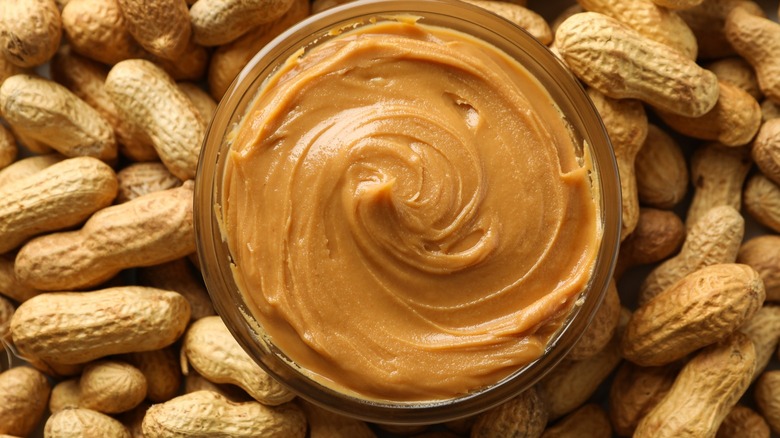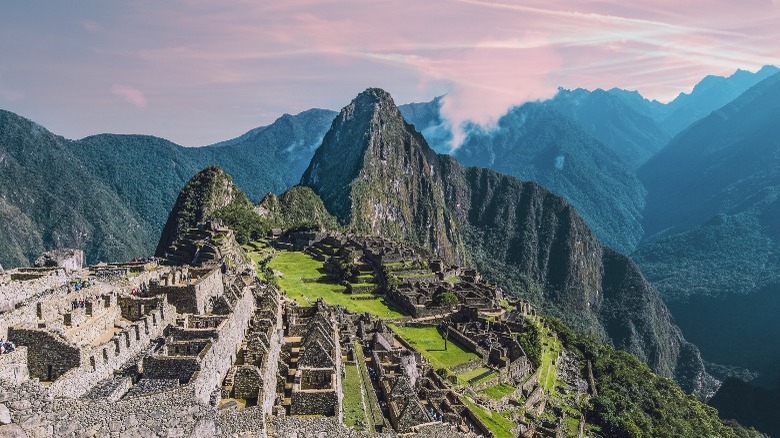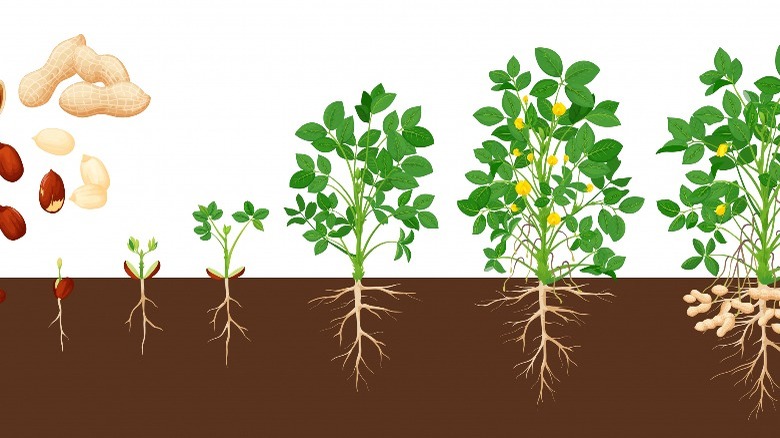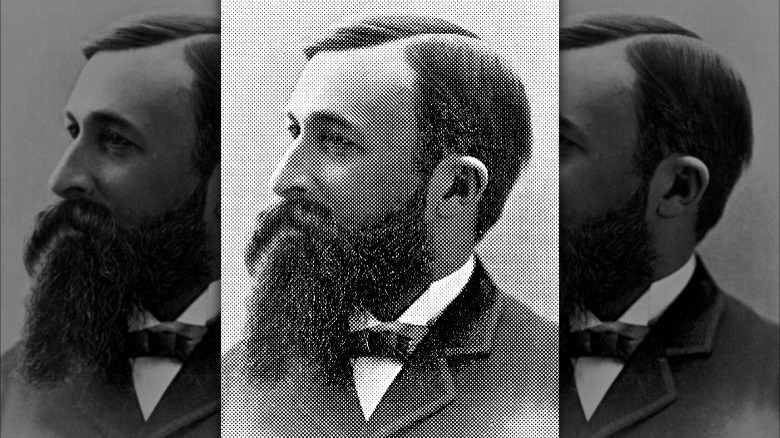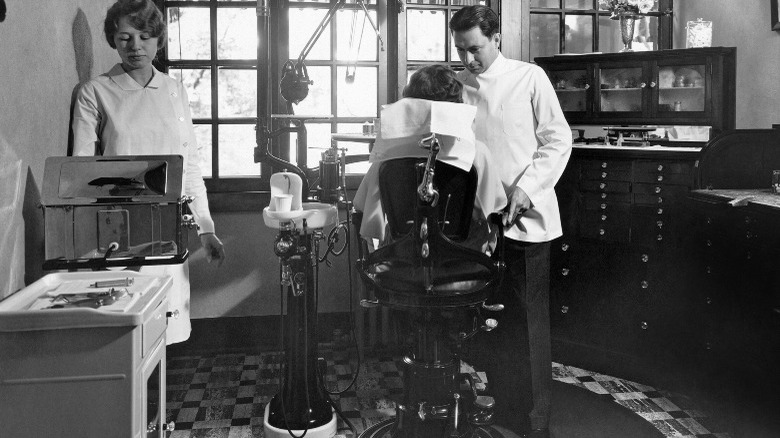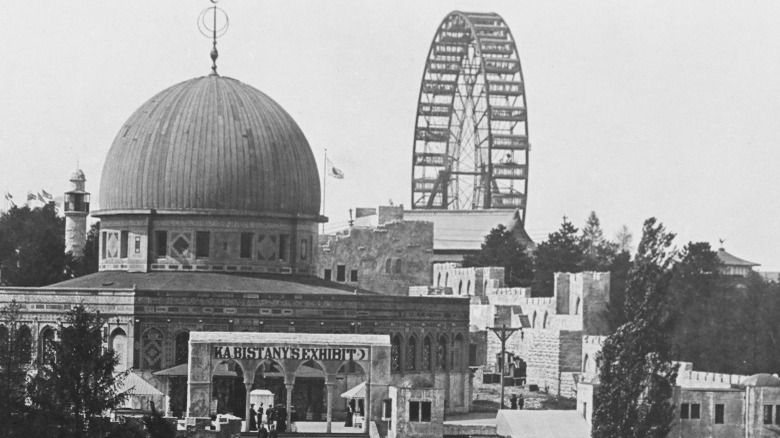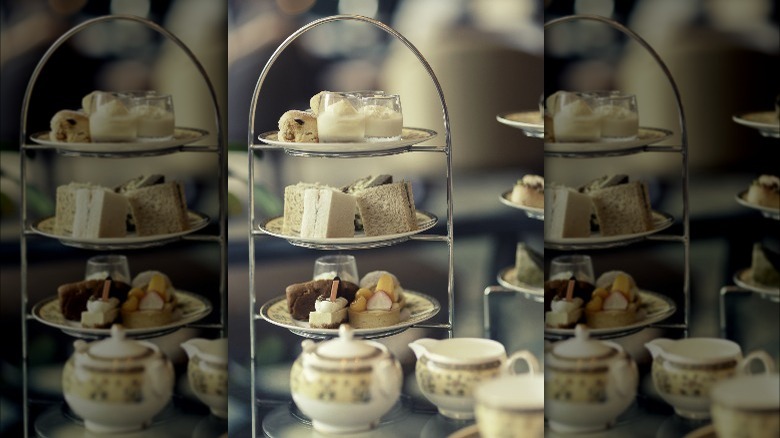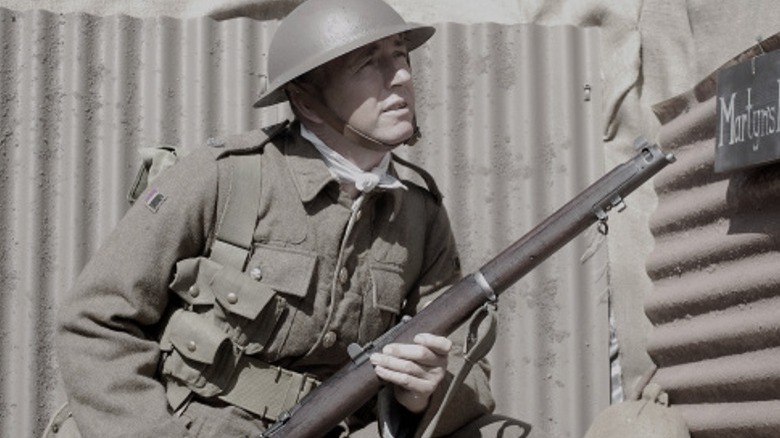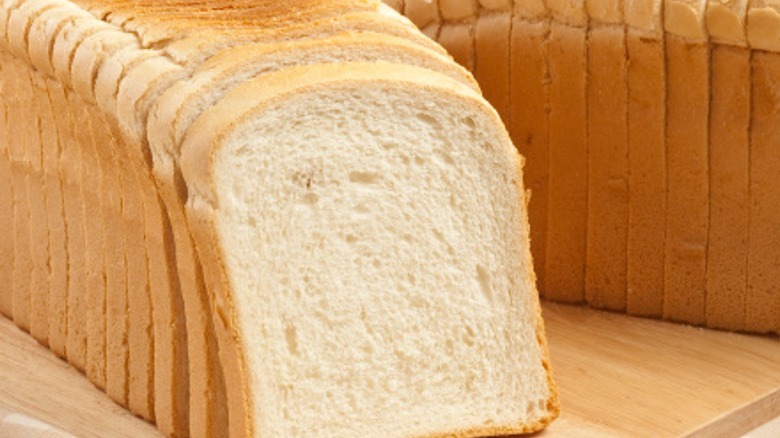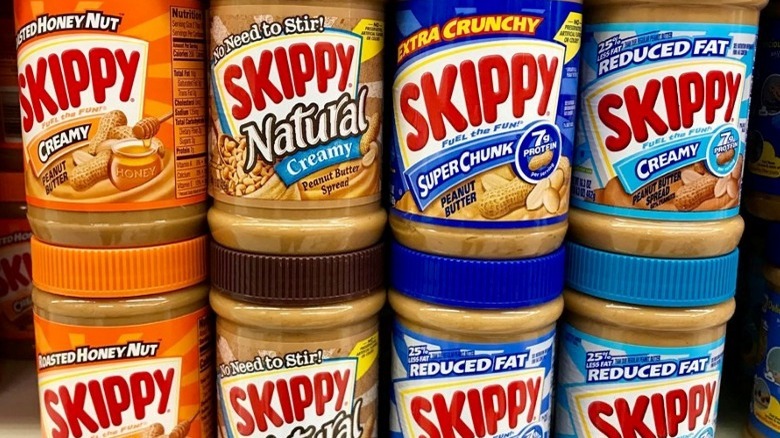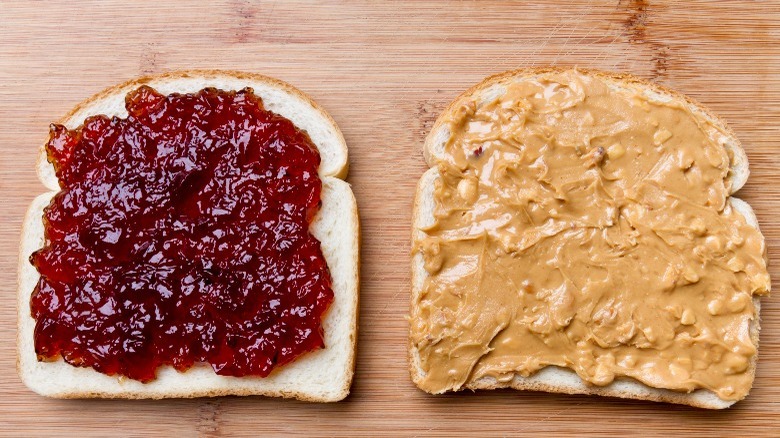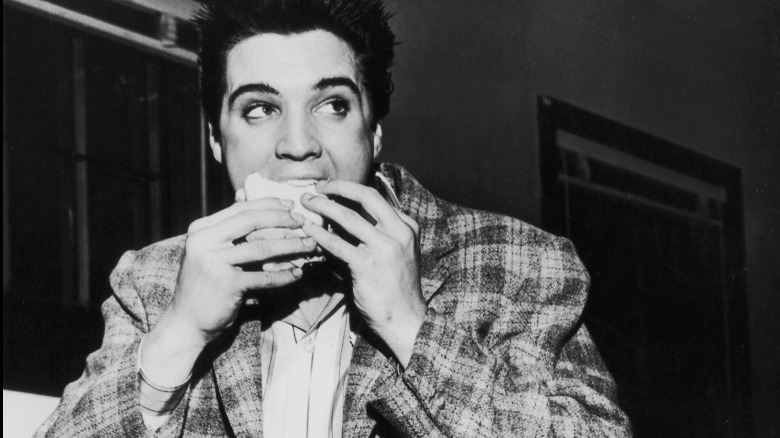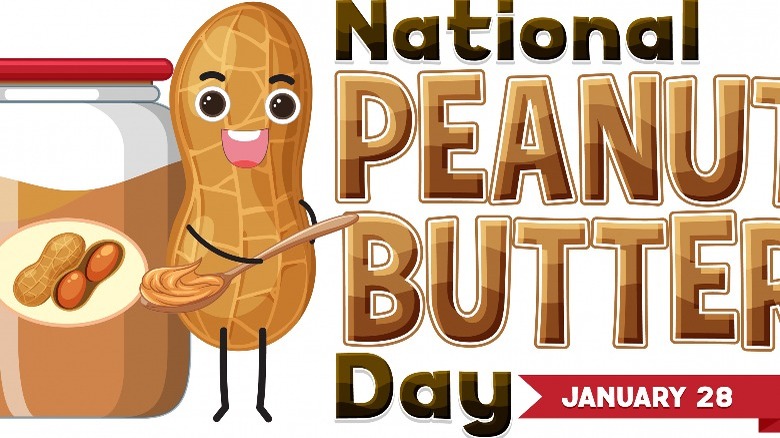The Truly Bizarre Origins Of Peanut Butter
Most grocery and convenience stores have peanut butter for sale, and it's so ingrained into the U.S. diet that most people don't think twice before grabbing a jar. The science of grinding up nuts into smooth, creamy butter might not be complicated, but the path taken from that first smushed peanut to warehouses and store shelves is truly bizarre. Don't think that a peanut farmer just decided one day to crush some up into butter one day because the real story is much more interesting.
While it's impossible to know the name of the first human who ground up peanuts, we know that these legumes were brought to this country in the 1700s. Now, there are endless brands and versions, from extra-crunchy to creamy PB made with dark chocolate. Retail peanut butter sales amount to about $850 million yearly, and peanut butter amounts to half of the U.S. use of peanuts. It's relatively inexpensive, unless you go for the high-end brands, and healthy to eat unless there's a lot of added sugar. Peanut butter is versatile and scrumptious, whether paired with jelly in a sammy or eaten straight out of the jar. Here's where it got its start and how things played out afterward.
Its origins can be traced to different countries
The true origins of peanut butter have been the subject of debate, with many stories told but not a great deal of solid proof for any one theory. It's been reported that Chinese chefs were crushing peanuts and using them in creamy sauce eons ago and that Africans were grinding peanuts into stews before recorded history.
There is some evidence that these legumes existed 3,500 years ago, and some researchers claim that peanut plants originated in South American countries like Mexico, Brazil, and Peru. There is peanut-shaped pottery and jars decorated with peanuts from that era, and around 1500 B.C., the Inca people buried peanuts with their dead to guide them on their journey to the afterlife. It's also theorized that the Incas were the first to grind the nuts into a paste and combine it with other ingredients like maize. But that's likely a far cry from what is found today on store shelves and in farmers' markets.
How peanuts came to North America
So if peanuts were first native to other parts of the world, how did they make their way to North America? The short answer is, colonizers brought peanuts back with them from travels. Enslaved Black Americans ate peanuts on ships that transported them to North America. Over time, they began planting them on North American soil. It wouldn't have been difficult to grow the plants since the nuts are in themselves seeds: The shells get popped open and the nuts get planted right in the ground.
Those peanuts were frequently used to feed livestock but they also made their way into household recipes. They became popular in the southern half of the U.S. and were eaten raw, boiled, or roasted. Peanuts were heavily consumed during the Civil War, and Union soldiers introduced them to the northern part of the country afterward. But peanuts didn't start moving toward mass production until John Harvey Kellogg entered the picture.
About John Harvey Kellogg
If the name Kellogg sounds familiar, it's because this family pioneered dry breakfast cereals like Frosted Flakes and Rice Krispies. John Harvey Kellogg earned a medical degree from Bellevue Hospital Medical College in 1875 and subsequently worked at Battle Creek Sanitarium (The San) in Michigan. While working there, he developed a range of foods for the patients and started serving them cornflakes for breakfast.
John Harvey is often confused with his brother W.K. Kellogg because they shared the same last name and worked together. The two founded the Battle Creek Sanitarium Health Food Company, which was eventually responsible for producing and managing food for the patients. A disagreement arose and W.K. split off, going on to form the Battle Creek Toasted Corn Flake Company in 1906. That is now the Kellogg Company.
John Harvey Kellogg was a vegetarian and was looking for dairy substitutes. Before forming his company with W.K., he devised a way to crush nuts between two rollers. The original plan was to find a non-dairy butter. He did that, but the implications were much greater than he probably ever thought.
John Harvey Kellogg's bizarre use of peanut butter
John Harvey Kellogg was a nutritionist and many recognized him as a food pioneer. He promoted plant-based diets and was known to experiment in his test kitchen. It's no surprise that he turned his focus to peanuts, although he wasn't shy about working with almonds, either.
The San had 700 beds in its heyday but it may have been as much of a spa as it was a medical facility. Famous people like J.C. Penney and Henry Ford were treated there and Kellogg also practiced surgery on some of the patients. He believed in the nutritional value of nuts, but many of The San's residents had poor teeth and couldn't chew peanuts or other hard foods. This was Kellogg's inspiration behind creating an easy-to-eat vegetarian paste.
He worked with his brother on experiments rolling and flattening whole grains before moving on to peanuts and almonds. The patients could easily consume the digestible butter, so the Sanitas Nut Food Company was founded. Since almonds were more expensive, peanuts were the ingredient of choice. In 1895, Kellogg filed his patent for this prototype peanut butter product.
The World's Fair and C.H. Sumner
Agricultural festivals have been taking place for hundreds of years and became larger and better organized in the 1600s. But in 1851, things were taken to another level at London's Great Exhibition. This international fair celebrated industrial progress and paved the way for subsequent ones held in Paris and Philadelphia. Visitors got to see exciting new products as well as the manufacturing processes.
The 1904 World's Fair was held in St. Louis and its theme was to commemorate the 100th anniversary of the Louisiana Purchase Treaty signing. There were exhibits from 43 U.S. states and 62 countries in total. Amazed attendees witnessed things like the world's largest organ and on a much smaller scale, containers of peanut butter for sale. These were brought to the site by C.H. Sumner, a man who made a name for himself for this very reason. He took in $705.11, per Kansas Living Magazine, but other than that detail there is little other information about Sumner. In today's economy, that amount of money would roughly equal $23,913.21.
Peanut butter became a food for the rich and famous
Before peanut butter gained widespread popularity, it was considered a luxury. It was hard to get in the early 1900s, so only those in the upper echelons were able to get their hands, forks, and spoons on it. One essentially had to visit elegant tea rooms in New York City to find it, and peanut butter was probably pretty expensive at the time as a result. Around the same time, homemakers were encouraged to use meat grinders to make their own peanut butter. One can only imagine how messy that might have been.
But as more companies started producing peanut butter, it became cheaper and more readily available. It was only a matter of time before people started slathering their bread with the stuff. And in the 1930s, things came full circle. A depression-era cookbook called "Five Roses" contained a recipe for peanut butter bread that incorporated about half a cup right into the batter.
The demand for PB grew in the 1900s
As the years went by and manufacturing processes improved, companies were able to produce large quantities of peanut butter. Technological advancements led to the development of equipment that allowed producers to plant, grow, and harvest peanuts faster. Mechanical devices were also used to shell and clean the nuts. Demand for peanut butter skyrocketed, and consumers wanted more roasted and salted nuts, too.
World War I soldiers were given peanut butter and jelly sandwiches as part of their rations, and after the U.S. joined the war, the availability of many grocery products in the country decreased. Civilians had less access to wheat, beef, and pork because the soldiers needed to be fed. The U.S. Government initiated a meat and wheat consumption reduction program. Meatless Mondays and Wheatless Wednesdays were catchphrases used during this time. Americans were probably consuming more peanut butter than ever before since that wasn't being rationed. A similar story with food rationing also took place in World War II.
The bread-slicing machine
Let's face it: Human beings like to avoid mundane tasks and prefer time-saving inventions. In past centuries, bread always had to be sliced by hand. But when fresh bread is sliced well in advance before serving, the inside gets exposed to air and it quickly becomes stale. This minor inconvenience led to an invention that also fueled the demand for peanut butter: the bread-slicing machine.
The inventor was none other than Otto Frederick Rohwedder, who hailed from Des Moines. He recognized the need for a contraption that would pre-slice bread for consumers and eventually came up with a design that wrapped it as well. He received the patent in 1932 and around that time sold the first bread-slicing machine to a baking company. But these technological innovations were only the first two parts of the nationwide craving for a creamy peanut butter and jelly sandwich. A few more things were needed and those will be covered next.
Along came Skippy
Peanut butter processing machines like the one used by John Harvey Kellogg made old-fashioned mortar-and-pestle grinding processes obsolete, and other inventors soon got into the game. One of the best-known PB machines was patented by Ambrose Straub in 1903, and his design sped up the process significantly. Still, once the butter was made, it didn't take that long for the oils to separate from the solids. Oxygen and light exposure sped things up, so back in those days, these products spoiled too quickly to be transported to faraway places.
This is why peanut butter was only made and sold regionally for a long time. But necessity is the mother of invention, and entrepreneur Joseph Rosefield patented a peanut butter manufacturing process to get around this inconvenient detail in the 1920s. His method added hydrogen atoms to peanut oil, and this hydrogenation worked to prevent problematic separation. Rosefield launched Skippy Peanut Butter in 1933and other similar brands soon followed.
The first PB&J recipe
Peanut butter on bread is nutritious and filling, but it's obvious that something is missing. Though PB is smooth and creamy, its somewhat thick and grainy texture can make it hard to swallow. A cold glass of milk is a perfect accompaniment but there's something better suited to share the bread space: jam or jelly.
The Boston Cooking School Magazine of Culinary Science and Domestic Economics reportedly published the first PB&J recipe in 1901, but this used crabapple or currant jelly. This was a precursor to the more widely known version that uses grape jelly. The first modern jam was created by Welch's in 1918, called Grapelade, and shipped to World War I soldiers. It was a bonafide hit and was introduced to the retail market five years later. Hydrogenated peanut oil, packaged sliced bread, and grape jam all led to the first mass-produced PB&J sandwiches that were sent to World War II soldiers. Families also loved them because they were tasty, inexpensive, full of protein, and could be slapped together in mere minutes. It was the perfect brown bag lunch for schoolkids and workers all over America.
The Elvis Sandwich
Peanut butter sandwiches have been and continue to be made with things other than jelly. Some enjoy it with fruit like bananas, grapefruit, and dried apricots, while others prefer savory additions like celery, cucumbers, or cheese. Plain white bread is still a classic option, but a thick sourdough or 100% whole wheat also does the job.
But nothing can compare to the peanut butter sandwich favored by The King, Elvis Presley. As the legend goes, his namesake sandwich was originally made at the Colorado Gold Mine Company restaurant in Golden, Colorado. It was called "Fool's Gold Loaf" and was anything but ordinary. Instead of white bread, the chefs hollowed out a loaf of French bread and filled it with PB, bananas, and bacon. And they didn't stop there: The whole thing was deep-fried. Elvis flew in his staff on his private jet to try the decadent treat, and later bought the recipe and shared it with his cook.
National Peanut Butter Day and peanut allergies
Peanut butter deserves its very own day each year, but it actually has two: National Peanut Butter Day in January and National Peanut Butter Lover's Day on March 1. But there's no reason to hold off eating it until then, and no one probably does. A Healthista survey completed in association with Pip & Nut revealed that nine out of 10 people have PB in their kitchens and 40% have more than one jar. According to this survey, the most-loved pairings are, in order of preference, bananas, chocolate, and jam.
People with peanut butter allergies may feel left out because they cannot enjoy the spread, but there are now some just-as-delicious substitutes. Peanuts are different from tree nuts like almonds because they're legumes. They actually have more in common with green peas and beans because their seeds grow in pods. Someone who's allergic to legumes and not tree nuts can enjoy almond or cashew butter. Another option is sunflower butter, which can be free of those allergens. Always check the ingredients first and when you find a safe one that you like, grab a few jars.
